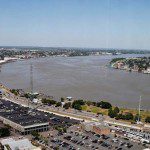This article was created by the Center for American Progress.
The Gulf Coast region, still reeling from the oil-laden assault on its ecosystem and livelihoods, is now bracing for what’s being called one of the worst cases of flooding since the 1920s and “the nation’s slowest moving natural disaster.” Economists are projecting billions of dollars in damages just as local Gulf-dependent industries such as fisheries, aquaculture, and tourism are struggling back to profitability after the devastating blows from Hurricanes Katrina and Rita and the BP oil spill.

Last week, residents braced for the worst-case scenario: levee breaks that could potentially exceed the damage wrought by Hurricane Katrina. To ease the threat of flooding in New Orleans and Baton Rouge, on Saturday the U.S. Army Corps of Engineers opened the Morganza Spillway for the first time in nearly four decades—sending a torrent of water toward thousands of homes in the French-speaking Louisiana countryside, “threatening to slowly submerge the land under water up to 25 feet (7.6 meters) deep.” The massive release of water from the Morganza and Bonnet Carre Spillway, which was opened earlier this month, means the river is slowly spreading across millions of acres of farmlands that contain enormous amounts of pesticides, fertilizers, and other chemicals that will eventually end up in the Gulf of Mexico.
In addition to immediate public health concerns, scientists are worried these pollutants will exacerbate the already enormous “dead zone” that occurs annually in the Gulf. The dead zone is a lifeless band of water off the coast that forms as a direct result of the influx of nitrogen-rich river water carrying massive quantities of fertilizer and pollution from upstream agriculture and industry. It fluctuates in size each year, and last year’s dead zone was larger than the state of Massachusetts.
Scientists expect the historic flooding could lead to the largest dead zone on record, which could stretch the massive area all the way to the Texas coast. An expanded dead zone will be a major stress on fish, shrimp, and other species struggling to rebound from last year’s oil spill because marine life will suffocate and die if it can’t swim away from or otherwise flee these hypoxic conditions. Thus, as the Thibodaux Daily Comet notes, it will be “another setback for fishermen trawling the Gulf in hopes of making up for last year’s spring fishing season, which was shut down in much of the state by the BP oil spill.”
Additionally, the unprecedented flooding will deal another major blow to the area’s already struggling oystermen. Nearly half of Louisiana’s entire oyster population was destroyed in the aftermath of the Deepwater Horizon catastrophe when floodgates were opened upstream to reverse the flow of the river and prevent oil-contaminated water from making its way further inland. As a result, the water became too brackish for the oysters to survive. An insurance program established in the wake of Hurricanes Rita and Katrina did not cover oil spills and was dismantled soon after the BP disaster, leaving oystermen ineligible for assistance. To make matters worse, earlier this year BP reneged on promises to help Louisiana pay for rebuilding oyster beds, claiming it wasn’t the one making the decision to open the floodgates.
Just when it looked as if Louisiana oysters were staging a remarkable comeback, the impending floods, and onslaught of fresh water, will shut them down again. Another collapse would be absolutely devastating for the state that produces 40 percent of the nation’s oysters. Mike Voisin, a seventh-generation oysterman, fears that for some of his hardest-hit colleagues, this latest setback will be “a knockout blow.”
Over the next week, millions of residents will be forced to pack up and head for higher ground while the worst of the flooding slowly makes its way toward their homes. In the words of Melville, LA, resident Gerry Krasgrow, “It’s like a monster coming down the river.” While the Gulf Coast region has shown such great resilience in the wake of Katrina and the Deepwater Horizon catastrophe, one has to wonder how many more hits they can take—and there doesn’t appear to be any relief on the horizon.


